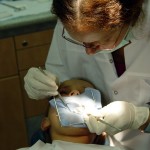
Rubber dam is recommended for isolating the working field during adhesive dentistry procedures. However, dentists often omit rubber dam, particularly in paediatric dentistry, supposing that it would stress the patient. The aim of this study was to evaluate subjective and objective stress parameters in children and adolescents during dental treatment when using rubber dam compared to relative isolation with cotton rolls and saliva ejector.
72 patients aged between 6 and 16 were randomised to receive fissure sealants under rubber dam (Test group n=34) or using rolls and saliva ejector (Control Group n=38). The patients parameters of stress (pulse rate, breath rate, skin resistance, blood pressure) were recorded at five measuring points as was the operators pulse. The patient’s subjective pain perception during treatment was recorded using a questionnaire as was the operators subjective mental and physical stress.
They found
- Significantly higher subjective perception of pain during treatment in the control group
- The control group had significantly higher breath and pulse rate,s but there were no differences in skin resistance response or blood pressure.
- Both the operators pulse rate and self-perceived mental and physical stress were lower when using rubber dam
- Time required to place the sealants was 12.4% lower in the rubber dam group
They concluded
This study reveals that in the hands of an experienced dentist, isolation with rubber dam is less stressful for children and adolescents than isolation with cotton rolls and can save valuable treatment time.
Ammann P, Kolb A, Lussi A, Seemann R. Influence of rubber dam on objective and subjective parameters of stress during dental treatment of children and adolescents – a randomized controlled clinical pilot study. Int J Paediatr Dent. 2012 Mar 8. doi: 10.1111/j.1365-263X.2012.01232.x. [Epub ahead of print] PubMed PMID: 22404253.
